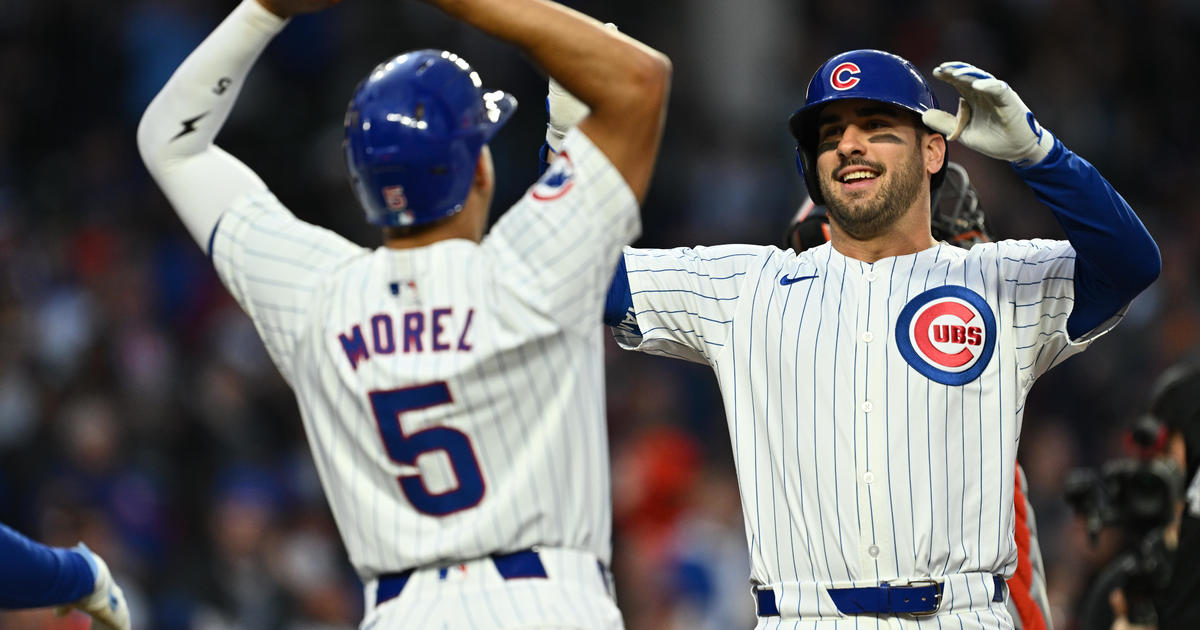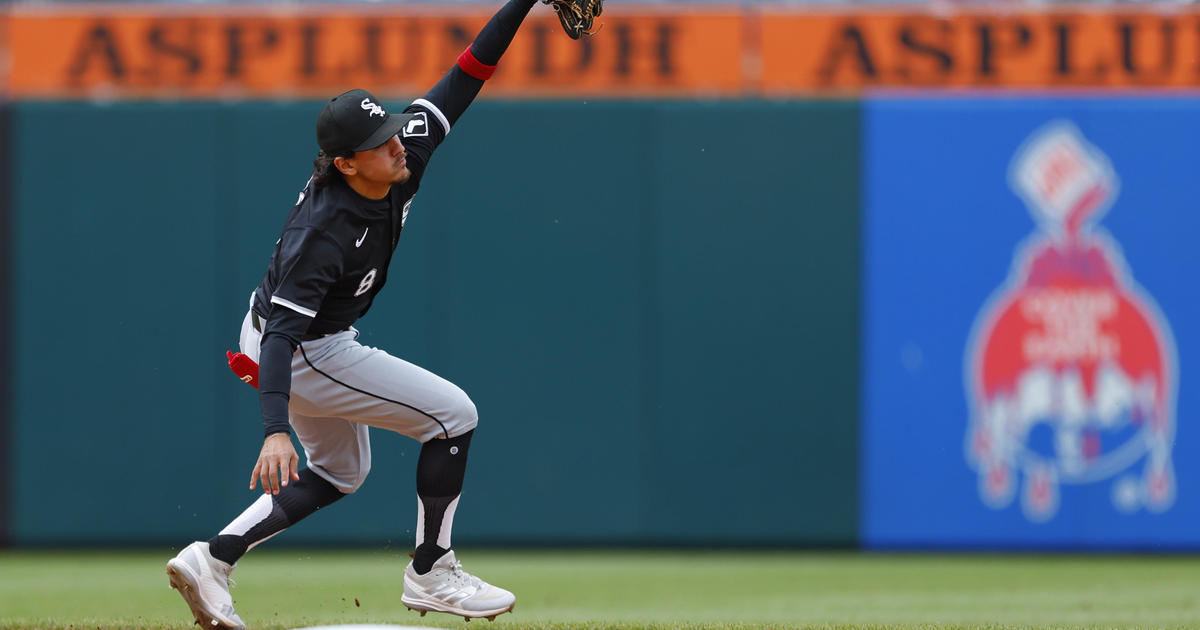Angi: No Need For White Sox To Trade Adam Dunn
By Cee Angi-
(CBS) Imagine for a moment that it's Opening Day 2014, and the Sox have their new lineup in place.
Marcus Semien, who earned a roster spot in spring training, leads off with a walk. The number two hitter, a new outfielder as yet unnamed, grounds out to third base but manages to advance the runner. Avisail Garcia hits a long single to right to put runners on the corners. The team's promising new Cuban slugger, Jose Abreu, takes a walk and now the bases are loaded with just one out in the first inning of the season.
It's time for the number-five hitter, and he digs his cleans into batter's box on the right side of the plate. Did Adam Dunn learn how to switch hit? Nope, he's been traded to one of the several AL teams in so desperate need of a DH that they did not scruple to accept a .220 hitter with 40-homer power (the White Sox eating $12 million of his salary in the process).
Standing in is Alexei Ramirez, who hit just six home runs and grounded into 17 double plays, the most on the team, last season. Ramirez battles, but the outcome is a weakly hit groundball to the shortstop, and the Twins turn an inning-ending double play.
Inning over; cue the sad trombones. Such is life without Adam Dunn.
Even in this fantasy, I'm not sure that Dunn would hit a grand slam if he's batting instead of Ramirez. Of course, it would be convenient for storytelling purposes if he did, but that would be a cheat. If we use his career outcomes as an indicator, there's a 28.4 percent chance that Dunn strikes out in that situation, leaving the bases loaded and two outs. There's a 15.9 percent chance that he takes a walk, which would put the Sox on the board early. And, 5.6 percent of the time he's going to hit a home run.
The White Sox hit just 148 home runs last season, which was fourth from the bottom of the league; if the Royals didn't exist, their total would be pretty much indistinguishable from last. Of the team's home runs, Dunn hit 34 (or 23 percent) and was sixth in the majors in home runs overall. As you've no doubt heard by now (and as mentioned above) the Sox signed another rumored slugger this week in 26-year-old Cuban first baseman Jose Abreu. Oddly, instead of inciting fantasies about how nice it might be to have two home run hitters in the lineup again, it's caused a wave of people calling for the Sox to finally get rid of Dunn once and for all, even if it means eating part of his salary to clear the roster spot.
This is shortsighted, but understandable: Dunn is a frustrating player. With Dunn, you have to dig beyond his batting average to see his value at the plate in terms of home run production and walks, weighting those against the low average and strikeouts. He can't field (nor should be allowed to), and he's no longer good enough against left-handed pitching to play every day (over the last four years he's hit .173/.290/.368 against left-handed pitching, albeit with 30 home runs in 565 at-bats), but there's still value in using him for 140-plus games as the designated hitter, especially on a weak offensive roster.
While no one could argue with a straight face that his performance has lived up to expectations (or earnings), he does bring value to the Sox' lineup and isn't as disposable as many would want you to believe. The 2013 Sox lost 99 games, and the majority of their struggles came from offense. While the Sox will be working to correct that this offseason, it's not likely they can find the caliber of offense help they need in one offseason, especially if they were to subtract Dunn.
Sure, if Abreu lives up to Rick Hahn's wildest dreams he might dazzle and hit, say, 44 home runs in his first season, but if you subtract Dunn's 34, that's just a net gain of 10. Some of Dunn's critics balk over the $15 million that Dunn will earn in the final year of his contract next season, but (a) that's a sunk cost; all or most of it is spent whether Dunn is here or elsewhere, so he might as well be here, and (b) that money won't be cost-prohibitive for the Sox, who have shrunk the payroll down to roughly $65 million next season, even with the Abreu signing. There's great relief in the fact that Dunn will be off the books and out of the lineup starting in 2015, but it's better to pay Dunn $15 million to play a full season for the Sox than to pay him $10-$15 million to play elsewhere because he's still producing offensively. Consider that the Angels are paying $18.6 of $21 million for Vernon Wells to suit up for the Yankees next season, and the Cubs will spend $13 million of the $18 million due Alfonso Soriano to do the same and you'll realize just how little money the White Sox stand to save by dumping Dunn.
In addition to his aforementioned 23 percent of the team's home runs, Dunn drew 18 percent of the White Sox's walks and had 15 percent of their RBIs. The Sox have already improved the offense for next year by adding Avisail Garcia, who will start in right field, and Abreu, but better hitters could in turn make Dunn more productive if they get on base more frequently in front of him.
Last season, Dunn hit .241/.349/.449 and nine home runs with runners in scoring position. Of the 360 baserunners that were on with Dunn at the plate, 14.4 percent of them scored. The major league leaders saw as many as 536 baserunners (Prince Fielder) and 450 (Paul Goldschmidt), so the White Sox have a long way to go before they furnish their cleanup hitter with enough runners that you can feel they let you down by not driving in 100 runs. All of the 15 hitters who drove in 100 runs in 2013 saw more runners than Dunn, in many cases vastly more. They averaged 437 runners. Give Dunn that many runners, assume consistency, and you get 97 RBIs. Give him as many as Prince Fielder saw and you get 111 -- or five more than Fielder had.
Before you package Dunn for delivery, also consider there's a competitive advantage in having a dedicated designated hitter, which the Sox will have next season with Dunn. There aren't many teams that rely on a dedicated DH anymore—the Red Sox and David Ortiz being something of an exception—and the position has become a resting spot for regulars who need a defense-free day while keeping their bats in the lineup. The consequence of that, of course, is that it's often a non-hitting utility player that gets the start in place of the half-resting starter, and the effect is really that of displacing an ideal hitter with a weak bat. While Dunn isn't going to be as productive at the plate as Ortiz has been, having the bulk of the designated hitter plate appearances go to Dunn would almost certainly be more productive than blowing them on Jeff Keppinger, Conor Gillaspie, or Paul Konkero (if they re-sign him).
The only reason to trade Dunn now would be if the Sox could get legitimate player value for him in return or a team was willing to take on the remaining $15 million of his salary (and we knew the team was going to reinvest the savings in a top-tier free agent as opposed to Jerry Reinsdorf's wallet), but that's not the reality. Dunn is such a limited player that there aren't many teams that would knowingly tolerate all of his nuances (a polite way of saying weaknesses), especially since teams have shied away from designated-hitter types in favor of specialized-bullpen arms. That is particularly true at this price.
The important takeaway with Dunn is to remember that this is the final season of the marriage; just 162 more games and he's out. But Dunn isn't the demon that so many perceive him to be: Those home runs and RBIs matter. They'll make him valuable to the Sox again next season, especially if they can solve their on-base problem.
Cee Angi is a freelance sportswriter, whose work has appeared at Baseball Prospectus, The Platoon Advantage, The Classical, and is currently one of SB Nation's featured columnists covering Major League Baseball. Follow her on Twitter @CeeAngi and read more of her CBS Chicago blog entries here.




